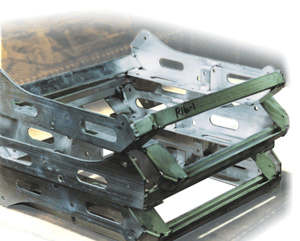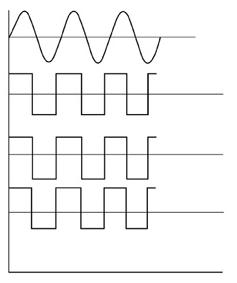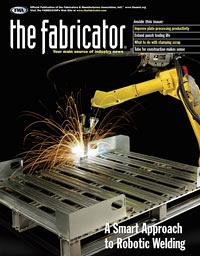President
- FMA
- The Fabricator
- FABTECH
- Canadian Metalworking
Categories
- Additive Manufacturing
- Aluminum Welding
- Arc Welding
- Assembly and Joining
- Automation and Robotics
- Bending and Forming
- Consumables
- Cutting and Weld Prep
- Electric Vehicles
- En Español
- Finishing
- Hydroforming
- Laser Cutting
- Laser Welding
- Machining
- Manufacturing Software
- Materials Handling
- Metals/Materials
- Oxyfuel Cutting
- Plasma Cutting
- Power Tools
- Punching and Other Holemaking
- Roll Forming
- Safety
- Sawing
- Shearing
- Shop Management
- Testing and Measuring
- Tube and Pipe Fabrication
- Tube and Pipe Production
- Waterjet Cutting
Industry Directory
Webcasts
Podcasts
FAB 40
Advertise
Subscribe
Account Login
Search
Preparing for aluminum GTAW
Proper equipment setup and workplace preparation reduce defects
- By Frank Armao
- April 24, 2001
- Article
- Aluminum Welding
Even if you are experienced in welding steels, aluminum welding can present quite a challenge. Aluminum's oxide coating, higher thermal conductivity, and lower melting point easily can lead to welding problems unless you know how to prepare for welding and set up the equipment.
Though many processes can be used to join aluminum, the most applicable process for lighter gauges and cosmetically appealing welds is gas tungsten arc welding (GTAW). This article explores the correct ways to set up welding equipment to accommodate the aluminum GTAW process and also discusses techniques for troubleshooting and solving common welding problems.
Advantages and Disadvantages of GTAW on Aluminum
There are advantages and disadvantages of using GTAW on aluminum. On the plus side, GTAW provides the highest-quality welds and offers a great deal of versatility, meaning that you can weld many material thicknesses and joint geometries. It also is easy to control and weld out of position. If an application has intricate welding requirements or uses thinner materials, GTAW usually is the process of choice.
On the downside, GTAW is a relatively slow process with a low deposition rate. It generally is not used for high-volume applications. In addition, the continuous high frequency associated with GTAW can interfere with robots, computers, and other sensitive equipment.
GTAW often is used for such applications as aluminum bicycle frames, architectural components, piping, wheelchairs, and aerospace work. It also is used to weld commercial airline engine casings, seat frames, and ductwork, as well as to repair existing components, such as cylinder heads.
Polarity and Power Sources
Most materials welded by GTAW require direct current with the tungsten electrode negatively charged and the piece to be welded positively charged. This is called straight polarity. In this mode, most of the arc's energy goes into the workpiece, which results in the best weld penetration. Aluminum can be welded this way, but it is very difficult.
More often with GTAW, aluminum is welded using alternating current (AC). In AC welding, the arc's action when the electrode is positive and the workpiece is negative, called reverse polarity, breaks up the oxide on the surface of the aluminum, making welding much easier.Unfortunately, reverse polarity doesn't provide good weld penetration. While in reverse polarity, much of the arc's energy goes into the tungsten electrode and the welding torch. For this reason, larger-diameter tungsten electrodes and heavier-duty torches, often water-cooled, are needed for AC welding.
The cleaning action created by the reverse polarity arc is important, but you do not want to clean more than is necessary, so equipment manufacturers have created a balance control. Found on the front of the machine, the balance knob allows you to adjust the amount of penetration (electrode negative) versus the amount of cleaning (electrode positive).
As a rule of thumb, not as much cleaning is needed with high currents as with low currents. Some machines even offer an autobalance feature that has preprogrammed balance based on the current being used.
While changing to AC sounds easy, it creates an unstable arc. When you look at a sine wave, note that as the current moves from positive to negative and then back again, it must pass through the zero point. When the voltage goes through the zero point, the arc can go out or become unstable.
To correct this unstable arc, welding manufacturers have superimposed a low-current, high-voltage radio frequency on top of the welding current. For most types of welding, this high frequency is used only to initiate the arc, but for aluminum GTAW, the high frequency is present continuously and acts like a pilot arc.
When selecting a power source, it usually is best to select a newer-technology square wave model, which alters the characteristics of the sine wave to create a more stable arc (see Figure 1). In addition, look for a balance feature, be it a manual or autobalance adjustment.
Workpiece Cleaning
Aluminum workpieces must be cleaner than steel workpieces to be welded effectively. The first step is to remove oils and greases from the workpiece by wiping the area with a solvent or washing it with a mild alkaline solution. The second step is to remove all oxides, which can be done with a stainless steel wire brush. Never use the same brush on aluminum and steel or it will become contaminated.
Not only do you need to clean before beginning to weld, but you also should remove the smut or soot between weld passes. This soot is fine particles of aluminum oxide and magnesium oxide. Proper welding techniques will minimize the amount of soot produced.
Shielding Gas
Usually, 100 percent argon gas is preferred for aluminum GTAW, but when working with thicker materials, such as 1/2 inch or greater, add helium in the range of 25 to 50 percent. Helium makes the arc hotter and provides for more penetration.
Electrodes
Most operators who weld with DC polarity are accustomed to using a 2 percent thoriated electrode with a sharp tip. But for AC aluminum welding, more heat is put into the tungsten, and the tungsten tip quickly becomes blunt. Once the tip is blunt, using 2 percent thoriated electrodes results in a fluttering arc, which wanders around on the blunt tip.
Instead, start with a blunt tip and use a pure tungsten or zirconiated tungsten electrode. (A zirconiated electrode carries more current than pure tungsten.) For AC welding, using a larger-diameter tungsten is advisable (see Figure 2) because one that is too small spits tungsten into the weld, creating a defect. Consider using a ceriated or lanthanated electrode. Both types of electrode are versatile and can be used for AC or DC welding.
Torches
If the welding application is light-duty fabrication requiring up to 150 amps, an air-cooled torch may suffice. Higher-amperage jobs require a water-cooled torch used with a water recirculator. One feature to look for in a good torch is a flexible head, which offers maneuverability and reaches tight areas. Because more heat input is used for AC aluminum welding than for DC welding, a torch that normally is used for DC GTAW may not have sufficient capacity.
Filler Metal
As a rule, filler metal is added to welds made by GTAW. However, most nonheat-treatable aluminum alloys can be welded without adding filler. This is referred to as an autogenous weld. Be careful, though, because if you try to weld any of the heat-treatable alloys, such as 6061, without adding filler metal, they will crack during the welding process (see Figure 3).
As a caution, not all aluminum alloys are weldable. Be sure you know which type of aluminum alloy you are welding, and then consult a filler metal chart. When handling filler metal, keep it dry in an airtight box to avoid contamination and a buildup of hydrated oxide.
When welding is completed, the weld bead should be bright and shiny without soot (see Figure 4). Approximately 1/16 to 1/8 inch on each side of the weld bead should have a bright strip, meaning that the oxide has been removed from this area by the welding arc. If the weld is black, an error has been made in the welding process. In most cases, this results when the arc is too long or the torch angle is wrong.
The weld also should have a distinct, uniform pattern of ripples on the surface and should be smooth, blending in well with the surrounding area. Remember that in steel, the weld is as strong as the parent; in aluminum, this is not always the case.
Conclusion
Even if you are new to aluminum GTAW, you can reduce the number of errors you make by brushing up on how to set the current and prepare the workpiece; selecting the proper gases, electrodes, and torches; and heeding advice from more experienced welders. In time, you will feel as confident welding aluminum as you do welding steel.
About the Author

Frank Armao
Aluminum Consulting Inc.
440-479-0239
Related Companies
subscribe now

The Fabricator is North America's leading magazine for the metal forming and fabricating industry. The magazine delivers the news, technical articles, and case histories that enable fabricators to do their jobs more efficiently. The Fabricator has served the industry since 1970.
start your free subscription- Stay connected from anywhere

Easily access valuable industry resources now with full access to the digital edition of The Fabricator.

Easily access valuable industry resources now with full access to the digital edition of The Welder.

Easily access valuable industry resources now with full access to the digital edition of The Tube and Pipe Journal.
- Podcasting
- Podcast:
- The Fabricator Podcast
- Published:
- 04/16/2024
- Running Time:
- 63:29
In this episode of The Fabricator Podcast, Caleb Chamberlain, co-founder and CEO of OSH Cut, discusses his company’s...
- Industry Events
16th Annual Safety Conference
- April 30 - May 1, 2024
- Elgin,
Pipe and Tube Conference
- May 21 - 22, 2024
- Omaha, NE
World-Class Roll Forming Workshop
- June 5 - 6, 2024
- Louisville, KY
Advanced Laser Application Workshop
- June 25 - 27, 2024
- Novi, MI



































